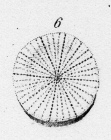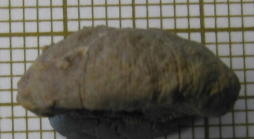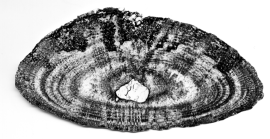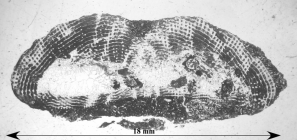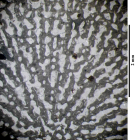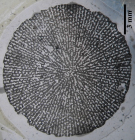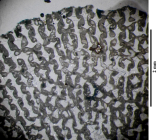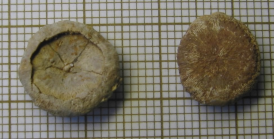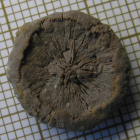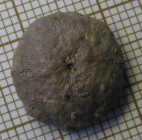Scleractinia taxon details
Chomatoseris Thomas, 1935 †
1439746 (urn:lsid:marinespecies.org:taxname:1439746)
accepted
Genus
Madrepora porpites Smith, 1816 † accepted as Chomatoseris porpites (Smith, 1816) † (type by original designation)
Anabacia d'Orbigny, 1849 † · unaccepted > junior subjective synonym (synonymy)
- Species Chomatoseris acaulis (Gregory, 1900) †
- Species Chomatoseris bouchardi (Milne Edwards & Haime, 1851) †
- Species Chomatoseris complanata (Defrance, 1820) †
- Species Chomatoseris fungiformis (Gregory, 1900) †
- Species Chomatoseris hemispherica (Milne Edwards & Haime, 1850) †
- Species Chomatoseris iranensis Flügel, 1966 †
- Species Chomatoseris jacobi Alloiteau, 1936 †
- Species Chomatoseris normaniana (d'Orbigny, 1849) †
- Species Chomatoseris normaniana d'Orbigny, 1850 †
- Species Chomatoseris orbulites (Lamouroux, 1821) †
- Species Chomatoseris porpites (Smith, 1816) †
marine, fresh, terrestrial
fossil only
Thomas HD. (1935). On Tricycloseris, Anabacia, and some new genera of Hexacoralla. <em>The Geological Magazine.</em> 72(9): 424-430. [details]
Description Solitary cyclolitoid corallum. No epitheca, no wall. Thin numerous radial elements, pennular and regularly fenestrate....
Description Solitary cyclolitoid corallum. No epitheca, no wall. Thin numerous radial elements, pennular and regularly fenestrate. Discontinuous menianae. The finely dentate pennular rims are directed toward the distal direction i.e. upward on the upper surface and downward on the lower surface of the adult stage. This means that the growth is centrifugal at the adult stage and suggests an aptation for mobility. Septa are straight but often anastomosed in a contratingent manner. Hexameral symmetry difficult to decipher and bilateral symmetry marked by the elongate axial pit in some species. In depth, inner edges of septa are anastomosted in the axial zone. Synapticule are numerous and rather uniformly distributed. Vesicular dissepiments present. [details]
Hoeksema, B. W.; Cairns, S. (2025). World List of Scleractinia. Chomatoseris Thomas, 1935 †. Accessed at: https://www.marinespecies.org/Scleractinia/aphia.php?p=taxdetails&id=1439746 on 2025-05-04
Date
action
by
original description
Thomas HD. (1935). On Tricycloseris, Anabacia, and some new genera of Hexacoralla. <em>The Geological Magazine.</em> 72(9): 424-430. [details]
original description (of Anabacia d'Orbigny, 1849 †) Orbigny, A. D. d'. (1849). Note sur des Polypiers fossiles. <em>Revue et Magasin de Zoologie, 2e sér.</em> 1: 526-538. [details]
basis of record Cairns, S.D., R. Baron-Szabo, A.F. Budd, B. Lathuilière, E. Roniewicz, J. Stolarski & K.G. Johnson. (2010). Corallosphere. , available online at http://www.corallosphere.org [details]
additional source Beauvais, L. (1971). Quelques précisions sur le genre Chomatoseris Thomas. C. R. Acad. Sci. Paris, 273, sér.D: 2219-2222. [details]
original description (of Anabacia d'Orbigny, 1849 †) Orbigny, A. D. d'. (1849). Note sur des Polypiers fossiles. <em>Revue et Magasin de Zoologie, 2e sér.</em> 1: 526-538. [details]
basis of record Cairns, S.D., R. Baron-Szabo, A.F. Budd, B. Lathuilière, E. Roniewicz, J. Stolarski & K.G. Johnson. (2010). Corallosphere. , available online at http://www.corallosphere.org [details]
additional source Beauvais, L. (1971). Quelques précisions sur le genre Chomatoseris Thomas. C. R. Acad. Sci. Paris, 273, sér.D: 2219-2222. [details]
 Present
Present  Inaccurate
Inaccurate  Introduced: alien
Introduced: alien  Containing type locality
Containing type locality
From editor or global species database
Comparison Other solitary microsolenid like Trocharaea or Trochoplegma do not grow downward. Genabacia is colonial. [details]Description Solitary cyclolitoid corallum. No epitheca, no wall. Thin numerous radial elements, pennular and regularly fenestrate. Discontinuous menianae. The finely dentate pennular rims are directed toward the distal direction i.e. upward on the upper surface and downward on the lower surface of the adult stage. This means that the growth is centrifugal at the adult stage and suggests an aptation for mobility. Septa are straight but often anastomosed in a contratingent manner. Hexameral symmetry difficult to decipher and bilateral symmetry marked by the elongate axial pit in some species. In depth, inner edges of septa are anastomosted in the axial zone. Synapticule are numerous and rather uniformly distributed. Vesicular dissepiments present. [details]
Remark G. Gill investigated very thoroughly Chomatoseris in many aspects (morphology, structure, ecology, biogeography, teratology, variability) and the genus was the basis for the description of pennules. (Gill et al., 1978; Gill, 1967; Gill, 1968; Gill, 1970; Gill and Semenoff-Tian-Chansky, 1971; Gill, 1977; Gill and Coates, 1977; Gill and Lafuste, 1971). Unfortunately the taxonomy of the species included in the genus is still not satisfying. 21 nominal species are cited in this genus or in Anabacia. Some are not Chomatoseris (forms with epitheca or wall, without downward growth). Then the distribution is questionnable for several occurrences. [details]
From editor or global species database
